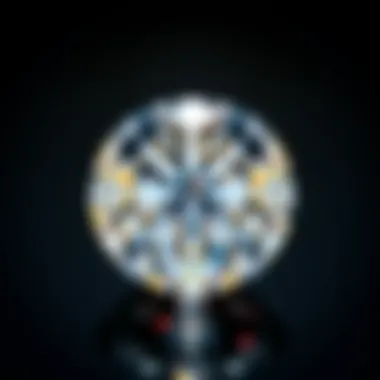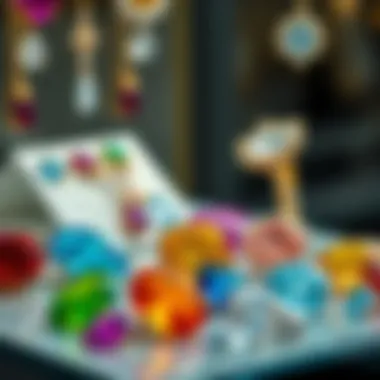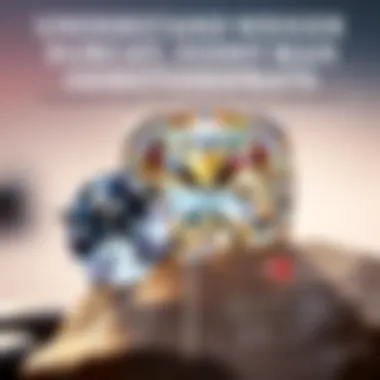Understanding 2 ct tw: Carat Weight in Gemstones


Intro
In the intricate world of gemstones, few terms hold as much weight—figuratively and literally—as '2 ct tw.' For those intertwined with jewelry or becoming enthusiasts, carat weight is a prominent consideration, influencing both the aesthetic appeal and value of their chosen stones. This exploration aims to demystify the carat weight terminology, probing into what 2 ct tw encapsulates.
The jewelry industry doesn't just rely on the term for its expressiveness. Understanding ‘two carat total weight’ is vital for anyone looking to make informed purchases, whether for personal adornment or investment. Carat weight acts as a fundamental pillar in gem evaluation, propelling buyers into a deeper comprehension of gemstones.
Without a thorough grasp of carat weight distinctions, enthusiasts may find themselves navigating a murky sea of options, devoid of clarity. By juxtaposing total carat weight with individual carat measures, we shed light on how each contributes uniquely to the gemstone's value.
Let's delve deeper into the world of gemstones and minerals, setting the stage for appreciating the intricacies of carat weight.
Defining Carat Weight in Gemstones
Carat weight serves as an essential indicator in the world of gemstones, often guiding both purchase decisions and valuations. This measurement, although commonly associated with diamonds, extends to a variety of precious and semi-precious stones. Understanding carat weight can profoundly impact both the monetary value and visual presence of a gem.
The Origin of Carat Weight
The term "carat" traces its roots back to the carob seeds that were historically used as weights for trading gems. The seeds offered a consistent size and weight, making them a reliable reference in ancient markets. As trade evolved, the metric system emerged, solidifying the carat at 200 milligrams or 0.2 grams. Despite its age, this measurement has remained a steadfast standard in the gemstone industry, establishing consistency across borders. Various countries adopted this weight system, creating a universal language among gem traders and collectors that fosters transparency and confidence in the buying process.
What Constitutes a Carat?
A carat equals 200 milligrams, but its significance goes beyond a mere weight measurement. It’s essential to note that carat weight does not always correlate with a gem’s size due to variations in cut and shape. For example, two diamonds may share the same carat weight, yet one may appear larger due to its cut brilliance. This often leads potential buyers to misunderstand the visual weight of a gemstone.
In gemstone valuation, every fraction of a carat can significantly affect the price. Larger gems tend to be rarer, causing their value to increase exponentially as the carat weight rises. It's not just a number; it’s the intersection of rarity, desirability, and visual appeal.
Understanding carat weight involves recognizing its impact on both appearance and value. It's not only about how heavy a stone is but how that weight presents itself visually.
Additionally, if budgeting a purchase, being aware of carat weight can help in making informed decisions. By understanding how carat weight influences a gem’s character and affordability, buyers can navigate the jewel marketplace with confidence.
This foundation of knowledge underscores the complexities of gemstone selection. Clarity around carat weight serves not just as a practical measurement; it ignites a deeper appreciation for gemstones, transforming casual interest into informed enthusiasm.
Total Carat Weight Explained
When discussing gemstones, especially in the context of jewelry, the term total carat weight (tcw) stands out as a pivotal concept. This designation does more than just quantify weight; it encapsulates the value and appeal of the stones, providing buyers with a clearer picture of what they are investing in. Understanding total carat weight is imperative because it directly correlates with cost, as well as the visual impact of the piece. Let’s delve into the details.
Understanding Total Carat Weight
Total carat weight is the cumulative weight of all gemstones in a piece of jewelry. For example, if a ring houses three diamonds weighing 0.5 carats each, the total carat weight is 1.5 carats. This term is commonly seen in jewelry descriptions, and it serves a few significant purposes:
- Perception of Size: The weight influences how large or showy a gemstone appears, which plays into the buyer's perception of value. A piece with a higher tcw often commands a higher price, even if the individual stones are smaller.
- Value Composition: Jewelers factor in total carat weight while considering the overall price of the jewelry. As the total carat weight increases, so too does the potential market value, provided the quality of the stones is also satisfactory.
- Market Trends: Buyers looking at total carat weight can better grasp current market trends. Larger weights tend to be more desirable, yet the demand for quality stones should never be overlooked.
The total carat weight is not just a number; it represents the story of the gems and their potential impact on the wearer’s style.
Understanding tcw is not just for buyers; sellers also need to advertise their pieces accurately, ensuring transparency regarding the total weight involved.
Calculating Total Carat Weight
Calculating total carat weight involves a straightforward process. However, care must be taken to be both accurate and honest. The simple formula to compute total carat weight is:
[ tcw = extsum of individual carat weights ]
To break it down further, follow these steps:
- Identify Each Gemstone’s Weight: Each stone in the jewelry piece should be weighed using a precise scale. Note that many gemstones are measured in carats (with one carat equivalent to 0.2 grams).
- Sum Up the Weights: Once the weight of each stone is taken, add them together to get the total carat weight.
- Accuracy is Key: Make sure to account for all stones in multi-stone settings. Ignoring even a small accent stone can misrepresent the overall weight.
In sum, calculating the total carat weight is not overly complex; it merely requires attention to detail. For anyone involved in buying or selling gemstones, mastering the art of calculating tcw can help facilitate informed decisions and transparency in transactions.
Differentiating Between Individual Carat and Total Carat Weight
Understanding the difference between individual carat weight and total carat weight is crucial for anyone involved in gemstones, whether you’re an enthusiast, collector, or designer. Carat weight serves not only as a measure of a gem's size but also influences its value significantly. In this section, we dive into the particulars of these metric and why having this knowledge matters.
Individual Carat Weight
When we talk about individual carat weight, we’re looking at the weight of a single gemstone. It’s expressed in carats, where one carat equals 200 milligrams. For example, if you're holding a diamond that weighs 1.5 carats, you can expect it to have a specific set of physical and aesthetic attributes based on that singular weight. One key point to keep in mind is that even if two stones are of the same carat weight, they may not have the same size appearance. Factors like cut, shape, and even the gemstone type can alter how a stone looks relative to its weight.
For instance, a 1-carat emerald can look smaller than a 1-carat diamond purely due to the way each gem interacts with light. Understanding individual carat weight helps in properly evaluating a gemstone, ensuring buyers know precisely what they're investing in and allowing them to make comparisons between similar stones more effectively.
Significance of Total Weight
Total carat weight (often abbreviated as t.w.) includes the combined weights of all the gemstones in a piece of jewelry. When you see a piece marked with ‘2 ct tw,’ it indicates that all the stones in that jewelry item sum up to a total weight of 2 carats. This concept is particularly important for pieces featuring multiple gems, such as rings or necklaces.
- Pricing: Total carat weight can significantly impact the price of jewelry. Generally, the higher the total carat weight, the higher the cost, even if the individual stones are of lesser quality.
- Visual Appeal: The combined weight can also affect the overall look of a piece. A piece with several smaller stones can exude brilliance and sparkle just like a single larger stone if crafted well.
- Investment Potential: In terms of resale value, understanding total carat weight offers insight into how one’s jewelry may appreciate over time. Larger total weights in popular gem types can lead to higher buyer interest down the road.
Quote: > "It's not just a number; it symbolises both beauty and value in the world of gemstones. "
For further insights on gemstone values, consider exploring resources on Gemstone Pricing and Gemstone Evaluation Techniques.
The Meaning of ' ct tw'
In the world of gemstones, the term '2 ct tw' holds considerable weight—both literally and figuratively. Understanding this phrase is crucial for anyone who is either purchasing or collecting gemstones. The expression signifies that the total carat weight of a collection of stones is two carats. It serves as a shorthand that communicates information about both size and value, which is pertinent for those deep into the gem trade or just starting their journey in jewelry.
When discussing the meaning of '2 ct tw', one must remember that carat weight is not merely a measurement; it carries with it a whole narrative concerning the gemstone's quality, appearance, and suitability for various types of jewelry. For instance, when you see '2 ct tw' on a price tag, you aren't just looking at the total mass—you're essentially gauging expectations around the radiance, craftsmanship, and possibly even where those stones came from.
This two-carats worth of gemstones is not uniform. The actual beauty lies in their individual characteristics. Knowing this distinction can make or break a purchasing decision.


Breaking Down the Term
To truly grasp what '2 ct tw' implies, one needs to dissect the terminology.
- Ct: This stands for carat, a unit of weight used for precious stones. Its origin can be traced back to the ancient practice of using carob seeds as a balance for measuring gems. As technology advanced, the measurement was standardized to equal 200 milligrams.
- Tw: The term stands for 'total weight'. This indicates that the carat value represents the combined weight of all the gemstones in a piece rather than a single stone. For example, if a ring features three small diamonds, their individual carats may add to the total of two carats, thus labeled as '2 ct tw'.
To illustrate, consider a ring showcasing a large sapphire of 1.2 carats paired with two smaller diamonds of 0.4 carats each. The total carat weight would be expressed as '2 ct tw', even though the sapphire commands most of the visual focus. Thus, when judging a piece of jewelry, it's critical to assess not just the total carat weight but how that weight is distributed across stones to gauge value comprehensively.
Contextual Implications in Jewelry
The implications of the term '2 ct tw' in the world of jewelry extend beyond mere numbers. Knowing this can be the pivotal aspect of a successful purchase, particularly for those eager to make astute investments.
When shopping for jewelry, professionals and enthusiasts alike understand that individual stones within a total carat weight can vary in shape, color, and quality, which can all affect the perceived brilliance and desirability of the piece.
Consider the following factors:
- Quality vs. Quantity: A pair of earrings may show '2 ct tw', but one might be of a higher quality stone, illuminating better and having a more vibrant hue than the other, thus affecting overall value.
- Market Trends: Sometimes, certain gems can demand higher prices because of popularity or rarity, so an understanding of trends helps buyers know if they are getting a reasonable deal.
- Personal Preference: Each buyer might have different tastes, and some may prioritize size while others seek exquisite craftsmanship or less-common shapes. An apt understanding of '2 ct tw' aids them in making a choice that resonates with their personal style without overspending.
This nuanced understanding of '2 ct tw' is pivotal for anyone looking to delve deeper into gemstones or make informed decisions in the jewelry marketplace. Those familiar with these concepts can approach their purchases with a heightened sense of clarity and purpose, ensuring that they invest wisely.
Factors Influencing Gemstone Value
When it comes to gemstone valuation, several factors come into play. Understanding them can help enthusiasts and collectors alike make informed decisions when acquiring or valuing their treasured pieces. Carat weight is the most critical of these factors, yet it isn’t the only one that counts. This section delves into the multifaceted nature of gemstone value and the key elements to consider.
The Role of Carat Weight
Carat weight plays a pivotal role in determining the value of a gemstone. Essentially, it measures how much a gemstone weighs, with each carat approximately equating to 0.2 grams. However, the value of carat weight extends beyond mere numbers; it operates within a framework where larger gemstones generally demand higher prices. This trend can often be perceived as straightforward, but variables such as the gemstone type can greatly influence the relation between size and price.
For example, a one-carat diamond may cost considerably more than a one-carat garnet. The rarity and desirability of the gemstone in question inflect the pricing structure, creating a distinct market dynamic. When considering a gemstone, it is crucial to assess how its carat weight fits within the larger picture of its unique characteristics and market demand.
The Importance of Quality Over Quantity
While carat weight can dictate a gemstone’s baseline value, it’s important to remember that greater weight does not automatically equate to higher quality. Factors such as clarity, color, and cut are just as vital, if not more so, in determining a piece's overall value. A well-cut gemstone that reflects light in a dazzling way can be far more desirable than a massive stone that lacks brilliance.
- Clarity: This refers to the presence of inclusions or blemishes within the gemstone. Flawless stones are rarer and thus command higher prices.
- Color: The hue of a gemstone plays a significant role in its valuation, especially for colored gemstones like sapphires or emeralds. Rich, vibrant colors are more sought after.
- Cut: The precision of how a gemstone is cut affects its sparkle and overall aesthetic. A poorly cut stone can look dull, irrespective of its carat weight.
Consider this: a two-carat diamond with impressive clarity and a masterful cut will stand out in a field of larger, lesser-quality gems. It’s a classic case of quality winning out over mere size.
In summary, while carat weight is an essential factor in the valuation of gemstones, it should not overshadow the importance of quality attributes that contribute to a gemstone’s allure and market value. It’s a delicate balance where each component interplays with the others to establish worth.
Remember, in the world of gemstones, beauty often lies in the eye of the beholder as much as it does in the numbers that define them.
For more information about gemstone valuations and market dynamics, you might want to check resources like GIA, or explore community discussions on Reddit.
Understanding these nuances can elevate not just purchases but the enjoyment of the fascinating world of gemstones.
Buying Tips for Gemstone Purchases
Purchasing gemstones can feel like navigating a maze, especially if one isn't familiar with the terms and nuances involved, such as the infamous carat weight. In this section, we will break down crucial components to consider when making such investments, focusing specifically on evaluating carat weight and how to understand market values.
Evaluating Carat Weight
When one is in the market for gemstones, the weight can seem like the most significant factor. But isn’t all about size? Not entirely.
- Look Beyond Just the Numbers: While a larger carat weight tends to draw the eye, it's vital to remember that the overall experience of the gemstone—its brilliance, cut, and color—plays equal if not greater roles in its appeal. Simply having a higher carat weight doesn't guarantee a breathtaking stone. A 2 ct gemstone might look smaller than a 1.5 ct one, depending on the cut and shape.
- Proportional Dimensions Matter: Don't get tangled in the idea that a higher carat means better value. A gemstone's dimensions can affect how it appears—two stones can share the same carat weight yet look vastly different. Always compare the depth, width, and overall appearance in relation to each other.
- Quality Over Quantity: Assess the clarity and color of the gemstone. Sometimes, a smaller stone with exceptional quality can surpass a larger stone that lacks sparkle or clarity. An eye-clean gem might shine brighter and be more desirable than a heavily included one that simply boasts more mass.
Visiting reputable jewelers, and perhaps armed with knowledge from sources like Gemological Institute of America, can lead one to discover what works best for them.
Understanding Market Values
Market values are always fluctuating—something that can be quite confusing when one is looking to buy gemstones.
- Research Market Trends: Keeping up with market trends is essential. Prices can vary significantly based on factors such as demand, market availability, or sometimes even seasonal influences. For instance, special pieces tied to certain events or celebrity endorsements can temporarily inflate prices, altering general expectations.
- Comparative Shopping: Don’t settle for the first gemstone that catches the eye. Compare various sellers, both online and local, to get a sense of what deals look like. Websites like Reddit often feature discussions where enthusiasts share insights on prices and reliable sellers.
- Certifications Are Key: Purchasing from Gemstone Certification bodies can be a great assurance of value. Look for documents that detail everything from the carat weight to the color grading of the stone. This not only adds assurance but can also help you gauge market values more accurately.
Remember, knowledge is power, particularly when it comes to investments such as gemstones. Gathering as much information as possible will undoubtedly lead to more informed decisions and should not be underestimated.
The more you know, the more confident you feel in your choices. This is especially true in a market like gemstones, where each piece tells a story and its value can be as complex as the emotions attached to it.
Common Misconceptions About Carat Weight
Understanding the intricacies of carat weight is essential for anyone delving into the world of gemstones, whether you’re a seasoned collector or a curious beginner. Despite its importance, many common misconceptions cloud the reality of what carat weight truly means. This section aims to dispel these myths while illuminating the nuances behind them, enhancing your appreciation for gem valuation and selection.
Size versus Weight
One of the most prevalent misunderstandings is equating size with weight. Many people presume that a larger gem will always have a higher carat weight—and thus, denote higher value. Picture a diamond that’s 1.5 carats, displayed proudly under a spotlight. It looks impressive. However, depending on the gemstone cut and shape, it may not actually be any larger than a 1-carat gem of a different cut. Camellia cuts, for example, are often flatter than brilliant cuts. Even though both might weigh similarly, the visual perception can be worlds apart.
In reality, two gems can hold the same carat weight but look dramatically different in size due to their cut and proportions. To grasp this concept effectively, consider the differences:
- Brilliant Cut: The facets are designed to capture light, giving a sparkly, voluminous appearance—this often makes the stone appear larger for its carat weight.
- Emerald Cut: This style has a unique rectangular shape, presenting a slimmer look which may make a 1-carat emerald cut seem smaller next to a similarly weighted brilliant cut.
This nuanced understanding helps buyers make informed decisions. Don’t let the allure of a size fool you. Always evaluate based on visual impact, not just carat weight alone.
The Fallacy of Price Predicting Quality


Another misconception is that price automatically signals quality. Many potential buyers fall into the trap of believing that if a gemstone comes with a hefty price tag, it must be of supreme quality. While price can be a factor, it’s essential to dissect what contributes to that price.
To put it plainly, a beautiful yet flawed gemstone can sometimes command a high price due to rarity or market trends, while a gem with slight imperfections may offer better visual allure and clarity for much less—think about that.
Several key considerations impact price that should not be overlooked:
- Origin: Gemstones from certain regions may naturally attract higher prices. For instance, Kashmir sapphires often command exceptional prices due to their coveted origin.
- Market Fluctuations: Demand can inflate prices regardless of an item’s inherent quality. A gemstone might be more expensive simply because it’s in vogue.
- Certification: A certified stone often comes with a higher price tag due to guaranteed quality assessments, but an ungraded gem might be visually stunning, offering more value.
To truly understand a gemstone's potential and worth, consider visual assessment and certification instead of focusing solely on price tags. Understanding this will keep you from overspending on a stone that is merely fashionable instead of truly valuable.
"A well-informed buyer isn't fooled by glitz and glam, but rather seeks true beauty and lasting value in every carat they consider."
By recognizing these misconceptions, gem enthusiasts become better equipped to evaluate and select the right gemstones based on a clear understanding of carat weight and associated factors. Knowledge is power in this realm, and with it, you navigate the gemstone market with confidence.
Exploring Gemstone Cuts and Shapes
When it comes to gemstones, the cut and shape are not just methods of polishing a stone. They play a pivotal role in how a stone appears in terms of brilliance and overall aesthetics. The artistry involved in these cuts can significantly affect the perception of carat weight. For instance, a well-cut diamond might appear larger than its actual weight, while a poorly cut one can look smaller, even if it has the same carat weight. This emphasis on cut quality cannot be overstated, as it directly influences consumer choices and investment value.
How Cut Affects Carat Weight Perception
Gemstone cuts can be likened to a tailor’s work in crafting a suit: if it’s tailored well, it enhances the overall appearance. The brilliance of gems, especially diamonds, is affected by angles and facets. A round brilliant cut, which is designed to maximize sparkle, can create an illusion of greater size compared to a step cut, like an emerald cut, which has broad, flat facets. Here are some specific ways cut influences perception:
- Light Reflection: The angles at which a stone is cut determine how light interacts with it. Well-crafted stones, with the right proportions, reflect light beautifully, making them appear more vibrant and thus more valuable.
- Shape Contribution: Certain shapes, such as an oval or pear cut, can visually elongate the stone. This elongation can make a gemstone look larger than it is, enhancing the perception of size without increasing carat weight.
- Face-Up Appearance: The way a gemstone presents itself when viewed from above is crucial. A deeper color saturation can make a stone of lesser carat weight appear outstandingly vibrant and visually larger.
"The effect of a gemstone cut can be profound, influencing not just beauty but also actual market value."
In summary, how a gem is cut serves a double purpose: enhancing beauty and influencing perceived weight. This is vital for buyers to understand in order to make informed decisions.
Popular Gemstone Cuts
When we talk about popular gemstone cuts, there's a plethora to explore. Each cut has its own character and appeal, often tailored to specific types of stones:
- Round Brilliant Cut: Dominating the market, this cut is synonymous with sparkle and fire, predominantly used in diamonds.
- Princess Cut: Square or rectangular, this cut maximizes light performance and is a favorite for engagement rings.
- Emerald Cut: Featuring step-like facets, this cut enhances clarity, often used for larger gemstones like emeralds and diamonds, showcasing their beauty in a sophisticated manner.
- Oval Cut: This cut is known for creating an elongated appearance that can make fingers look slimmer when used in rings.
- Asscher Cut: A variation of the emerald cut, it comes with a square shape and is famous for its vintage aesthetic and exceptional brilliance.
- Cushion Cut: With rounded corners and larger facets, this cut combines modern and vintage appeal, often enhancing the color and brilliance in colored gemstones.
Choosing a cut often comes down to personal preference and the gemstone’s natural properties. Each cut can add or detract from the visible carat weight, making it essential for any buyer or enthusiast to understand the implications of their choice.
The Impact of Gemstone Treatments on Value
In the realm of gemstones, treatments can have a profound influence on both the beauty and value of a stone. Understanding these treatments is essential for anyone interested in gemstones, whether you're a collector, designer, or simply passionate about jewelry. Treatments can enhance the color, clarity, and overall appearance of gemstones, leading to higher market values. However, they can also complicate the purchasing process, making it crucial to be well-informed.
Treatment Methods and Carat Weight
Gemstones undergo various treatments that can modify their characteristics. For instance, many sapphires and rubies are heat-treated to enhance their color. This treatment can significantly affect their carat weight perception. When a stone is treated, it may appear larger or more vibrant, but the underlying carat weight remains unchanged. Here are some common treatment methods:
- Heat Treatment: Used primarily for sapphires and rubies, this process improves color but does not add to the carat weight.
- Clarity Enhancement: Oils or resins penetrate inclusions in stones like emeralds to increase their clarity. While this makes the stone look better, it doesn't change its weight.
- Dyeing: Stones like agate and jade may be dyed to achieve a desired look. Again, this process alters the visual appeal, not the carat weight.
- Irradiation: Certain gemstones receive radiation to enhance color, typically seen in diamonds. This method influences how light interacts with the stone, but not the weight itself.
It’s essential to recognize that while treatments may enhance appearances, they do not impact the intrinsic carat weight—a facet critical to valuation in the gemstone market.
Informed Decisions on Treated Gems
When considering treatments, being informed is key to making wise buying decisions. The value of treated stones can vary vastly. For example, a treated stone may be priced significantly lower than its untreated counterpart due to potential concerns about longevity and market acceptance.
- Research: Before purchasing, it's advisable to consult gemological reports or certificates from recognized authorities like the Gemological Institute of America (GIA) or the American Gem Society (AGS). These documents detail the treatments and any implications for the gemstone's value and durability.
- Consider Resale Value: If you plan on selling or upgrading your gemstones in the future, be mindful of how treatments affect resale. Treated gems often do not hold their value as well over time.
- Understand Buyer Perception: Some buyers are wary of treated stones; knowing this can temper expectations on market price and desirability.
By arming yourself with knowledge about treatment types, effects, and the implications on value, you can navigate the gemstone market with confidence. This knowledge ensures that you won't land in a situation where you pay top dollar for something that may not hold the same value tomorrow.
"Understanding treatment methods is not just about aesthetics; it's about making informed choices that can affect both personal satisfaction and financial investment."
For further reading on gemstone treatments, consider visiting comprehensive resources like Gemology.org or reliable Wikipedia entries on gemstone treatments.
The Relationship Between Carat Weight and Rarity
Understanding the relationship between carat weight and rarity is critical for anyone dabbling into the world of gemstones. Carat weight measures the size of a gemstone, while rarity plays a pivotal role in determining its value. This relationship can be quite intricate, as different gems have varying levels of availability, which can significantly influence pricing.
A gemstone's carat weight does not exist in a vacuum; it interacts closely with its rarity. When a gem is both heavy and rare, its value can skyrocket, much more than a commonplace gem of the same weight. For instance, a 2-carat pink diamond, which is exceedingly scarce, fetches much higher prices than a 2-carat white diamond, due primarily to the pink diamond's rarity.
Rarity's Influence on Pricing
Rarity's influence on pricing cannot be overstated. When assessing gemstones, the market tends to value rarer stones significantly higher. Not only because of supply, but also because of the demand for unique, one-of-a-kind gems. Take emeralds, for example; a 2-carat Colombian emerald is likely to cost more than a 2-carat amethyst because the emerald is far more rare in the market.
- Supply vs. demand: Higher demand coupled with low supply leads to a surge in prices. If a specific gemstone is found in limited quantities, even gemstones of the same weight can vary greatly in cost.
- Unique features: Sometimes, rarity is enhanced by the unique attributes of the gem, such as exceptional color, clarity, or other characteristics that appeal to collectors.
- Market trends: Trends can shift, impacting the desirability of certain gemstones, with rarer stones often commanding higher prices during a surge in interest.
As the jewelry industry evolves, staying informed about which gemstones are considered rare can guide collectors and buyers in making sound investment decisions.
Understanding Gemstone Availability
Gemstone availability is a key consideration when evaluating carat weight in the context of rarity. Different types of gemstones have different levels of availability. Some may be as common as dirt, while others are so scarce they barely make it to auction.
For example, sapphires and rubies are relatively abundant and can be found in various qualities and colorations. In contrast, gemstones like tanzanite and painite are rare and can be difficult to source. These underlying factors are essential:
- Geological formation: The conditions under which gems form can greatly affect their availability. For instance, a specific gem might only be found in a certain location which limits its supply.
- Mining practices: The techniques used in mining also play a part, as some gemstones can only be harvested via methods that may not be economically viable, further restricting supply.
- Legislation and conservation: As awareness grows regarding environmental impact, some regions impose stricter regulations on gem mining, which can affect availability.
Long-Term Value and Investment Potential


When diving into the realm of gemstones, the topic of long-term value and investment potential cannot be overstated. Gemstones aren't just decorative; they’re tangible assets that can appreciate over time. The allure of investing in gemstones lies not only in their beauty but also in their capacity to retain and grow in value, provided one understands the nuances involved in their selection and valuation.
Investment in gems such as diamonds, sapphires, or emeralds can offer a hedge against inflation, similar to real estate or precious metals. However, navigating this landscape requires more than just passion; it calls for a sound understanding of various elements that influence a gemstone's long-term worth.
Carat Weight as an Investment Metric
Carat weight plays a pivotal role in gemstone valuation. Generally, larger stones are more desirable, but the way carat weight correlates with value isn’t always straightforward. Some essential considerations include:
- Size and Quality: A 2 ct diamond may be exceptionally valued if paired with high clarity and cut quality, compared to a poorly cut 3 ct stone that appears less appealing.
- Market Dynamics: The demand for specific weights and types can fluctuate. For example, a trend might favor elegantly smaller stones for engagement rings, impacting how a 2 ct tw gem is perceived.
- Rarity: Some gemstones, like certain colors of sapphires or untreated birthstones, can command a premium price due to their scarcity, irrespective of carat weight.
Thus, while carat weight is a fundamental metric, one must also weigh it alongside quality attributes and current market trends.
Future Market Trends
Gemstone investment trends evolve, influenced by both societal impulses and geological discoveries. Analysts project several noteworthy trajectories to watch:
- Sustainability Focus: Growing concerns regarding ethical sourcing will drive demand for sustainably mined stones. Gems with certification from recognized bodies are likely to gain favor, ensuring buyers are purchasing ethically responsible products.
- Custom Jewelry: There's a noticeable shift toward personalized jewelry, with buyers looking for unique pieces rather than traditional, mass-produced options. This could lead to changes in how carat weights are viewed in relation to individual style.
- Digital Platforms: The increasing prevalence of online marketplaces means that buyers have access to an array of gemstones like never before. This accessibility allows for easier comparison and can additionally drive demand for specific carat weights or styles.
"Investing in gemstones demands more than enthusiasm; it requires an informed and strategic mindset that melds beauty with practicality."
For those keen on delving deeper into these topics, resources such as Gemology Online and American Gem Society offer valuable insights and educational materials.
The Role of Certification in Gemstone Value
Gemstone certification plays a crucial role in determining the value of a gemstone. When you look at a sparkling gemstone, you might see beauty and allure, but the true worth lies in the details that a certification provides. In this section, we’ll explore the nuances of certification, outlining its importance and the impact of grading reports on buying decisions.
Importance of Certification
When it comes to purchasing gemstones, the phrase "buyer beware" rings particularly true. Without proper certification, one can easily get lost amid the myriad of colors, cuts, and carat weights, potentially overpaying for a stone that doesn't meet expectations or perhaps even might not be genuine. Here are several key reasons why gemstone certification is essential:
- Authenticity Assurance: Certifications are typically issued by reputable gemological laboratories. They provide assurance that the gemstone is authentic and confirms its type.
- Value Transparency: A certified gemstone comes with a clearer understanding of its value as it reflects certain qualities including brilliance, color, clarity, and cut, which directly impact pricing.
- Guidance on Treatments: Many gemstones undergo treatments to enhance their appearance. Certification helps disclose whether a gemstone has been treated and what those treatments might be. It’s critical for potential buyers to know this, as it can affect the stone’s value and durability.
- Investment Protection: If a gemstone is to be viewed as an investment, certification is crucial. It often adds a layer of security for buyers since it can potentially support resale value later on.
Ultimately, certification is an invaluable asset when it comes to ensuring that what you see is indeed what you’re getting.
Understanding Gemstone Grading Reports
Gemstone grading reports provided by certified gemological labs detail the qualities and characteristics of a gemstone. Here’s what you can typically expect to find in such a report:
- Carat Weight: This indicates the size of the gemstone—a fundamental factor impacting value.
- Cut Quality: This section evaluates how well the stone has been cut and faceted, affecting light performance and overall appearance.
- Color Grading: Grading systems like D to Z for diamonds or specific color scales for colored gems are used to define color quality.
- Clarity Assessment: This details the internal and external flaws of the stone (if any). Flaws can significantly affect the market price.
- Identification of Treatments: Here, the report will disclose any treatments the stone has undergone, such as heating or irradiation, which can influence overall desirability and value.
Generic grading terms can make some reports confusing for buyers. It's wise to familiarize yourself with the terminology and standards used by different labs. Remember that some grading systems are more consistent and reliable than others. Reputable labs like the Gemological Institute of America (GIA) or the American Gem Society (AGS) have stringent grading criteria.
"A gemstone certification is like a passport. It tells the story of its origin, attributes, and journey to the market."
Understanding these elements not only boosts confidence in your purchase but also ensures you’re valuing gemstones appropriately based on established characteristics rather than just intuition or surface appearance. With the data provided through grading reports, you can make informed decisions rooted in a combination of art and science.
Emerging Trends in Carat Weight Perception
As our understanding of gemstones and their market fluctuates, emerging trends in carat weight perception offer a fascinating glimpse into the evolving dynamics surrounding gemstone valuation. The conversation around gemstone weights, and particularly carat weight, is slowly but surely shifting. More than mere digits on a scale, consumer perception of carat weight is increasingly influenced by aesthetics, ethics, and individuality. This transformation in mindset is particularly relevant as we delve into the uncharted territories of personal value in gemstones.
Changing Consumer Preferences
In recent years, we’ve witnessed a noticeable shift in consumer preferences when it comes to gemstone purchases. It's no longer just about possessing larger stones; buyers are becoming more discerning, prioritizing unique characteristics over sheer size. The allure of distinctive cuts, colors, and even the story behind a gemstone is increasingly drawing attention.
- Craftsmanship over Size: Many individuals now place a premium on the artistry involved in gemstone cutting. A well-cut smaller stone often trumps a poorly cut larger one in both beauty and value. For example, the brilliance of a finely cut diamond can surpass the weight of a larger, less skillfully manipulated stone.
- Diverse and Ethical Sourcing: Shoppers are more inclined toward gemstones that come from responsible sources. This awareness leads many to favor ethically sourced alternatives, like moissanite or lab-created gems, which offer color and clarity without the substantial carat weight.
- Meaning and Personal Connection: Gemstones with a compelling story or personal significance now hold greater appeal than generic, mass-produced options. A buyer may choose a smaller gemstone that resonates with their life experiences rather than simply opting for the biggest rock. This inclination fosters connections that far transcend monetary value.
The Future of Gemstone Sizes
Looking ahead, the conventions of gemstone sizing may undergo a significant reevaluation. As preferences shift, the standard expectations of carat weight could become outdated. Instead of striving for the largest stones, the emphasis is likely to swing towards versatility, customization, and meaningful choices.
- Emerging Alternatives: With advances in technologies such as laser cutting, jewelers can produce smaller yet intricately designed pieces that captivate the eye and deliver beauty that’s well-worth the investment. Consumers might find that a 0.75 carat stone can still sparkle just as brightly as a full carat, depending on how it's crafted.
- Market Adaptation: Jewelers and retailers may need to adapt by embracing this changing landscape. This might mean offering educational resources to help consumers understand the value propositions of various weights and designs.
- A Shift in Retail Strategy: Instead of promoting carat weight as the be-all and end-all, marketing strategies may pivot toward storytelling and personal significance. This change could redefine the retail landscape, shifting the focus from simple carat comparisons to promoting the overall aesthetic and emotional value of gemstones.
As society continues to progress, so too does our appreciation for gemstones. The future may well favor those who cherish the depth and individuality a stone can offer over its sheer weight in carats.
As we ponder these trends, it becomes evident that the gemstone market is moving towards a realm that values meaning and personal preference as much as, if not more than, traditional measures like carat weight.
Ending: The Importance of a Comprehensive Understanding
In the realm of gemstones, grasping the nuances of carat weight, especially the concept of '2 ct tw,' is pivotal for both enthusiasts and potential buyers. It goes beyond mere numbers; it’s about appreciating the very essence of what these beautiful stones represent. As this article has explored, understanding carat weight informs not only the valuation of the gemstones but also how they fit into the larger picture of jewelry design, investment, and personal preference.
Understanding carat weight has significant implications:
- Value Assessment: Knowing how to distinguish between total carat weight and the individual carat weights of the stones enhances one’s ability to evaluate the worth of a piece accurately.
- Smart Purchases: Equipped with knowledge, buyers are less likely to fall into traps set by misleading marketing or superficial branding. They can make purchases that truly reflect their desires and needs.
- Investment Perspectives: For many, gemstones aren't just decorative items; they’re seen as long-term investments. By understanding how carat weight impacts value and rarity, collectors can make informed decisions that align with their investment goals.
Ultimately, a comprehensive understanding empowers the individual, whether a seasoned collector or someone wearing a piece of jewelry for the first time. By taking the time to understand the intricacies of carat weight, buyers can appreciate each stone’s unique characteristics and worth.
Summarizing Key Takeaways
Reflecting on the entire discussion, there are a few key points that stand out:
- Definition and Importance: '2 ct tw' refers to total carat weight, factoring in all stones in a piece of jewelry.
- Distinction is Key: It's crucial to differentiate between individual carat weight versus total carat weight when evaluating gemstones.
- Market Awareness: Understanding gem valuation helps navigate through the market effectively, ensuring sound investment decisions.
Recognizing these elements can immensely impact one’s experience and satisfaction when interacting with gemstones.
Encouraging Informed Choices in Gemstone Selection
As we conclude, the focus now shifts to encouraging thoughtful selections among consumers. Armed with knowledge and awareness, buyers can engage in a nuanced dialogue about their purchases. Here are some strategies for making informed decisions:
- Research: Familiarize yourself with the different types of gemstones and their grading systems. Knowledge is power, especially in an industry that can be overwhelming.
- Evaluate Sources: Not all gemstone sellers provide reliable information. Verify whether the jeweler is reputable and whether they offer certification for their stones.
- Prioritize Personal Preference: Ultimately, remember that your choices reflect your tastes and values. Choose what speaks to you rather than what others suggest.
With these considerations in mind, individuals are equipped to navigate the gemstone market wisely, leading to selections that are both satisfying and sound investments.







